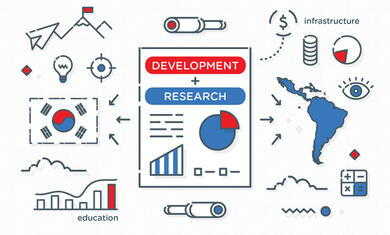
Millennial women: How to get them to make better financial decisions?
It's not just about educational improvements and opportunities. One of the greatest challenges of our region is to involve more millennial women in socially responsible financial decisions.

Can your trip to the beach help reduce poverty?
As summer comes to an end in the Northern Hemisphere, many of us have been asking and answering the same question: how was your vacation? Our responses typically include anecdotes about the food, people, and places we encountered along the way. Perhaps we could also be asking ourselves how our vacation impacted those people and places.

What can the private sector in Latin America and the Caribbean learn from Korea’s economic miracle?
They say that Korea achieved in three decades what it took the Western industrialized countries more than a century to do. But, how did it do that?

Supporting sustainable palm oil in Latin America and the Caribbean
African palm oil accounts for the bulk of vegetable oil sales in the world, and it is estimated that demand for this oil will grow significantly in the near future. But how is palm oil used? Although many of us are unaware of all its potential uses in industry, we use palm oil daily in a great variety of products, such as processed foods (ice creams, cookies, spreads, etc.), cosmetics, and automobile fuel. Review the labels on the products you use frequently and you will be surprised.

How to support business productivity: three lessons learned in Brazil
Increased productivity is considered the only sustainable model for improving living conditions over the long term: it reduces the use of resources and increases production, which is reflected in higher per capita gross domestic product (GDP) and is a necessary – although not always sufficient – condition for wage growth. Unfortunately, in Latin America and the Caribbean, productivity has not increased since the mid-70s, and has in fact shrunk in many countries. A recurrent action by governments to change this situation is the creation of business support programs. Although the model varies according to sector and country, the basic argument is the same: market deficiencies keep companies from reaching their potential; if these obstacles were eliminated, companies could operate more efficiently and generate greater social well-being based on increased competition, innovation and access to external markets or better coordination in value chains. Business-support programs: the case of Brazil But are business support programs of this type really effective? To answer this question, a recent study by the IDB Office of Evaluation and Oversight analyzed the case of Brazil, where nearly 900,000 companies received more than 1.4 million government subsidies to support their productive activities between 2002 and 2012. During this period, 5.4 million mostly small-sized companies (75% had less than 10 employees in 2012) were operating in the country, basically in the trade and services sectors. 16.4% of these companies participated in at least one productive support program, primarily in the form of capital provided for investments. The largest companies, which also offered better salaries and employed workers with higher educational levels, generally received training for export and support for innovation. Support in the form of working capital and, to a lesser extent, investment capital, benefitted smaller companies, with lower salaries and employees with lower educational levels. The Results: What can we learn from them? Due to the intertwined nature of the programs, it is difficult to link effects and interventions, so that the study focuses on the nearly 600,000 companies that only participated in a single program. The results are not very promising: there have been few effects on productivity or other indicators. One of the positive results determined by the study is that the survival rate of the beneficiary companies (90%) exceeded the average for Brazilian companies (67%). However, in only a few companies was it possible to draw a connection between the interventions and increased productivity. The results, although better in support programs for companies in the industrial sector, were rarely positive for the trade and services sectors. In fact, the interventions tend to be associated with decreased salaries and employment. These results point to the need to redefine the scope, design and monitoring of business support programs in Brazil, and leave us with key challenges for improving their efficacy in the future: Improved incentives: given that productivity is not explicitly defined in the programs as an expected outcome, the programs have no incentives to encourage companies to invest in new technologies and take measures to increase efficiency. Coordination of efforts: even though several programs are designed to work in combination or at least in parallel with others, the results suggest the need to optimize the current mechanisms for coordination among organizations working together. Results measurement: difficulty in evaluating some of the programs underscores the importance of incorporating monitoring and evaluation mechanisms in their design, which will make it possible to learn from the results. Understanding the effect of productive development programs on companies and on the economy, beyond the Brazilian case, requires additional analyses, but this study can be a starting point. I invite you to access all the data here. Subscribe to receive more content like this! [mc4wp_form]

Can innovation testing help boost private sector development in Latin America and the Caribbean?
Knowledge is increasingly seen as a key factor in promoting higher levels of productivity, competitiveness, and growth of firms. Despite this, innovation testing remains an untapped resource that can help boost private sector development in Latin America and the Caribbean. What is the best pricing scheme to maximize the demand for a product? Can technology increase the productivity of providers in a value chain? What type of product design can have the largest demand? What are the benefits to society or wider development impacts generated by a new product or service? These are questions that could be answered with an innovation testing exercise. What is innovation testing? We refer to innovation testing as the set of studies that include a randomized control trial in which an innovative approach is being tested. The final objective is to understand the cause and effect relationship between an innovative business practice or change (e.g. new product, new business approach, innovative marketing strategy, etc.) and the effects generated by it in an outcome of interest or a target population (e.g. increased demand, change in client behavior, etc.). Testing is conducted by empirically constructing a counterfactual or control group that tells you what would have been the situation in the absence of the proposed change. At the center of testing, there are considerations of cost-effectiveness, profit maximization, scalability, replicability, and/or development impact. For a long time, the private sector has been an important engine of knowledge generation and there are multiple examples of this. Back in 1842, entrepreneurs in the manufacturing industry were already experimentally testing the impacts of inorganic and organic fertilizers on crop yields, marking the beginnings of the chemical fertilizer industry. In the pharmaceutical sphere, private sector discoveries account for 80% to 90% of pharmaceutical products in the market and the industry is regularly conducting clinical trials of new drugs before introducing them into the market. Moreover, marketing companies are constantly relying on AB testing techniques to identify changes to web pages or advertisements to maximize an outcome of interest. For example, Google+ knew that with a full-screen ad that encouraged mobile website visitors to download the app, 69% of people left the mobile website right away, while 9% of the visitors clicked on the “Install” button. After they implemented and tested a nicer, less obtrusive app ad, the 1-day active users on mobile increased by 17%. Why consider innovation testing? For achieving best results managers are increasingly moving away from guessing when doing business towards using data-driven evidence to guide their decisions. Innovation testing can bring important benefits, both in terms of learning and accountability. For those in an expansion or starting phase, it can bring important learning lessons on what works and what doesn’t work before scaling up. For those seeking to explore new approaches to doing business, it can give them responses on how to design and select the business strategy that is the most cost-effective. For those seeking to generate evidence about the wider impacts or benefits they generate in society, testing can provide them with rigorous empirical evidence about their work. This is important, in this growing trend of impact investors seeking to generate social and environmental impacts beyond financial returns. It is also valuable for financial institutions that are increasingly seeking transparency and accountability. Despite the knowledge generation appetite coming from the private sector, the use of these methods remains widely concentrated in large companies and mostly in developed countries. The reality is that conducting innovation testing exercises requires technical expertise, time, and resources. In recent years, multiple firms have embarked in innovation testing exercises and multiple support platforms have emerge to help conduct these analyses. For example, Google Analytics offers support for online experiments to test which version of a landing page results in the greatest improvement in a metric value. Amazon Machine Learning Research has been conducting studies to scale-up AB testing techniques by proposing more efficient tools that help with multivariate testing and with learning how to implement ideas to reach the highest number of customers. The financial sector has also been very keen to use casual testing approaches to better tailor financial products and services to customer’s real behavior and to improve financial-decision making processes. How do we promote innovation testing? Development Banks working with the private sector bring new opportunities to support their clients with technical skills to conduct innovation testing while simultaneously providing financial additionality. Innovation testing is a key element in the IDB Invest Development Effectiveness agenda, as reflected in our annual Development Effectiveness Overview (DEO). Our focus when supporting causal testing is twofold: helping boost private sector growth while maximizing development impact, so that this becomes in a win-win opportunity for the region. We have exciting testing projects in progress related to the impacts of manufacturing companies promoting healthy practices; the effects of using machine learning techniques to increase farmer’s productivity in agribusiness value chains; and the use of technology to improve debt repayment and savings among clients of financial institutions, among others. There is still much work to do in Latin America and the Caribbean and the first step comes from the private sector demanding more hard evidence and business intelligence. This, coupled with continued support from experts in these techniques can only strengthen and boost private sector development in the region. We invite you to collaborate with us and learn more about our work at our recently launched Development Through the Private Sector Series. To know more download our first publication here. Subscribe to receive more content like this! [mc4wp_form]